SSW102: Anti-Oppression Practice and Social Identity Analysis
VerifiedAdded on 2022/08/10
|7
|1559
|19
Project
AI Summary
This project, completed for SSW102, focuses on anti-oppression practice by evaluating the student's social identity and identifying dimensions that influence oppressed groups. The paper explores the impact of social class, education, race, ethnicity, and gender on individuals and families. It analyzes the concept of multiplicity and intersectionality, highlighting how race and class interact to reinforce social dominance. The project discusses allyship, examining the student's role and motivation in combating oppression, including biases and power dynamics. The conclusion emphasizes the importance of allyship in promoting social justice and addresses how the student can utilize their privilege to support others. References are included to support the analysis of anti-oppressive practices.
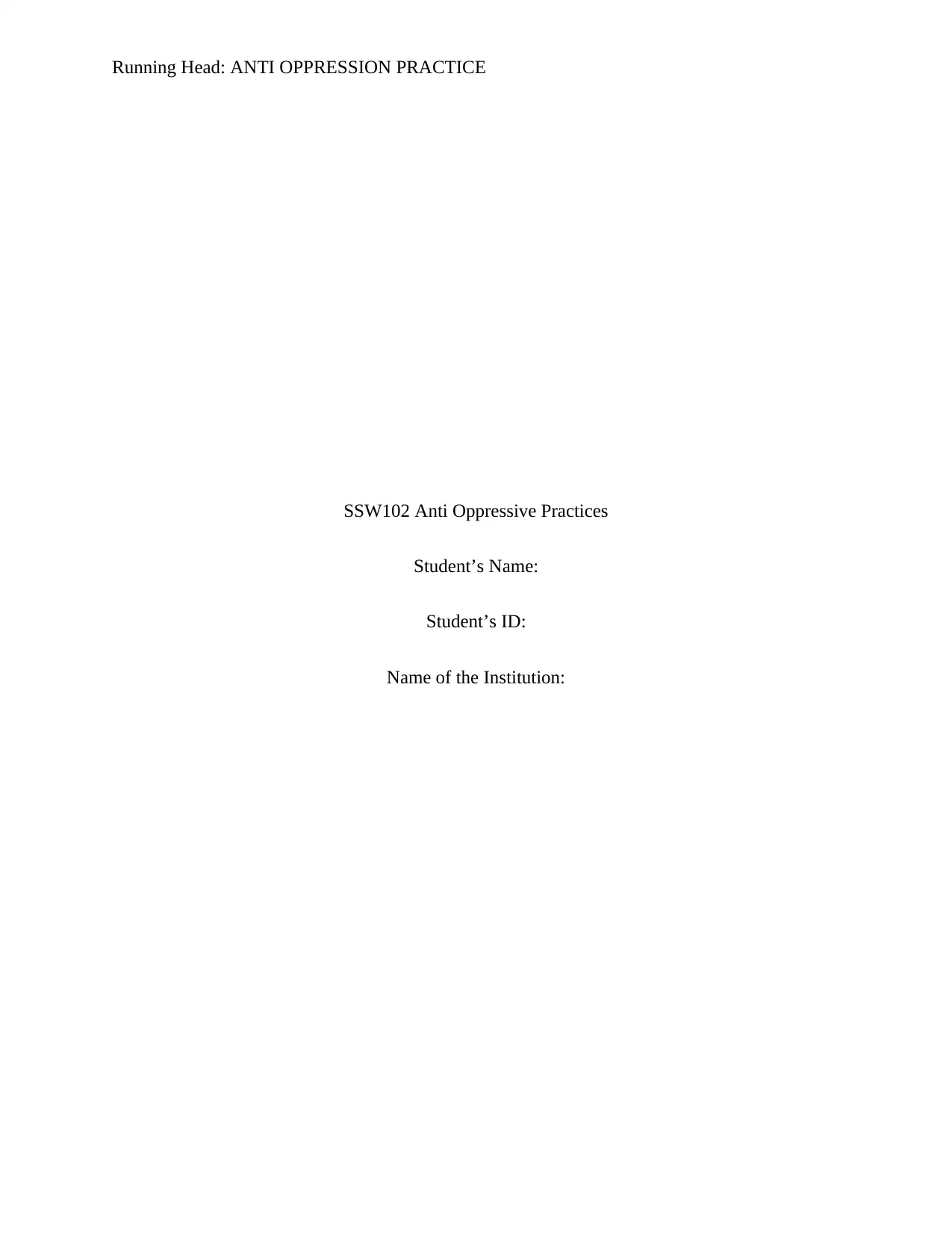
Running Head: ANTI OPPRESSION PRACTICE
SSW102 Anti Oppressive Practices
Student’s Name:
Student’s ID:
Name of the Institution:
SSW102 Anti Oppressive Practices
Student’s Name:
Student’s ID:
Name of the Institution:
Paraphrase This Document
Need a fresh take? Get an instant paraphrase of this document with our AI Paraphraser
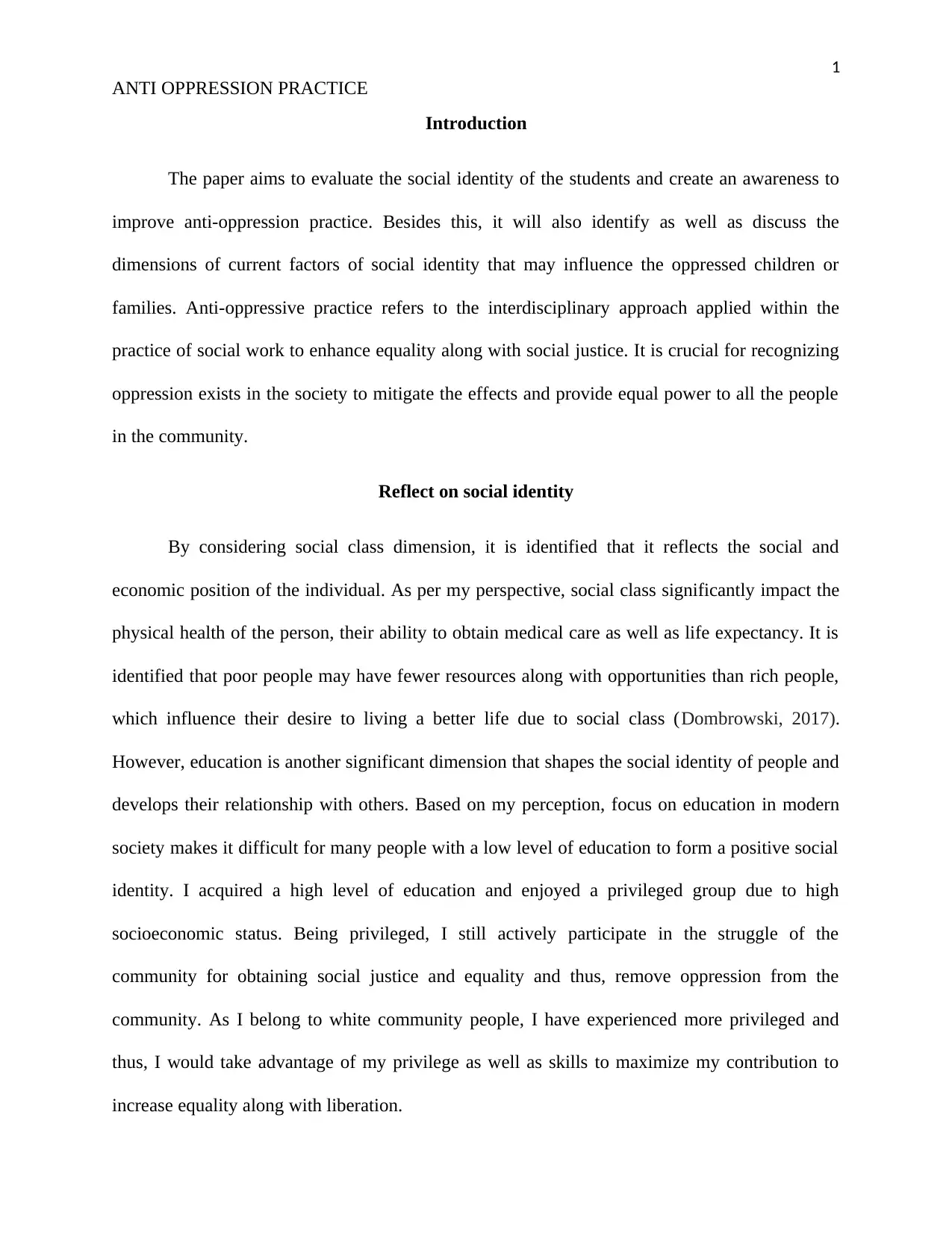
1
ANTI OPPRESSION PRACTICE
Introduction
The paper aims to evaluate the social identity of the students and create an awareness to
improve anti-oppression practice. Besides this, it will also identify as well as discuss the
dimensions of current factors of social identity that may influence the oppressed children or
families. Anti-oppressive practice refers to the interdisciplinary approach applied within the
practice of social work to enhance equality along with social justice. It is crucial for recognizing
oppression exists in the society to mitigate the effects and provide equal power to all the people
in the community.
Reflect on social identity
By considering social class dimension, it is identified that it reflects the social and
economic position of the individual. As per my perspective, social class significantly impact the
physical health of the person, their ability to obtain medical care as well as life expectancy. It is
identified that poor people may have fewer resources along with opportunities than rich people,
which influence their desire to living a better life due to social class (Dombrowski, 2017).
However, education is another significant dimension that shapes the social identity of people and
develops their relationship with others. Based on my perception, focus on education in modern
society makes it difficult for many people with a low level of education to form a positive social
identity. I acquired a high level of education and enjoyed a privileged group due to high
socioeconomic status. Being privileged, I still actively participate in the struggle of the
community for obtaining social justice and equality and thus, remove oppression from the
community. As I belong to white community people, I have experienced more privileged and
thus, I would take advantage of my privilege as well as skills to maximize my contribution to
increase equality along with liberation.
ANTI OPPRESSION PRACTICE
Introduction
The paper aims to evaluate the social identity of the students and create an awareness to
improve anti-oppression practice. Besides this, it will also identify as well as discuss the
dimensions of current factors of social identity that may influence the oppressed children or
families. Anti-oppressive practice refers to the interdisciplinary approach applied within the
practice of social work to enhance equality along with social justice. It is crucial for recognizing
oppression exists in the society to mitigate the effects and provide equal power to all the people
in the community.
Reflect on social identity
By considering social class dimension, it is identified that it reflects the social and
economic position of the individual. As per my perspective, social class significantly impact the
physical health of the person, their ability to obtain medical care as well as life expectancy. It is
identified that poor people may have fewer resources along with opportunities than rich people,
which influence their desire to living a better life due to social class (Dombrowski, 2017).
However, education is another significant dimension that shapes the social identity of people and
develops their relationship with others. Based on my perception, focus on education in modern
society makes it difficult for many people with a low level of education to form a positive social
identity. I acquired a high level of education and enjoyed a privileged group due to high
socioeconomic status. Being privileged, I still actively participate in the struggle of the
community for obtaining social justice and equality and thus, remove oppression from the
community. As I belong to white community people, I have experienced more privileged and
thus, I would take advantage of my privilege as well as skills to maximize my contribution to
increase equality along with liberation.
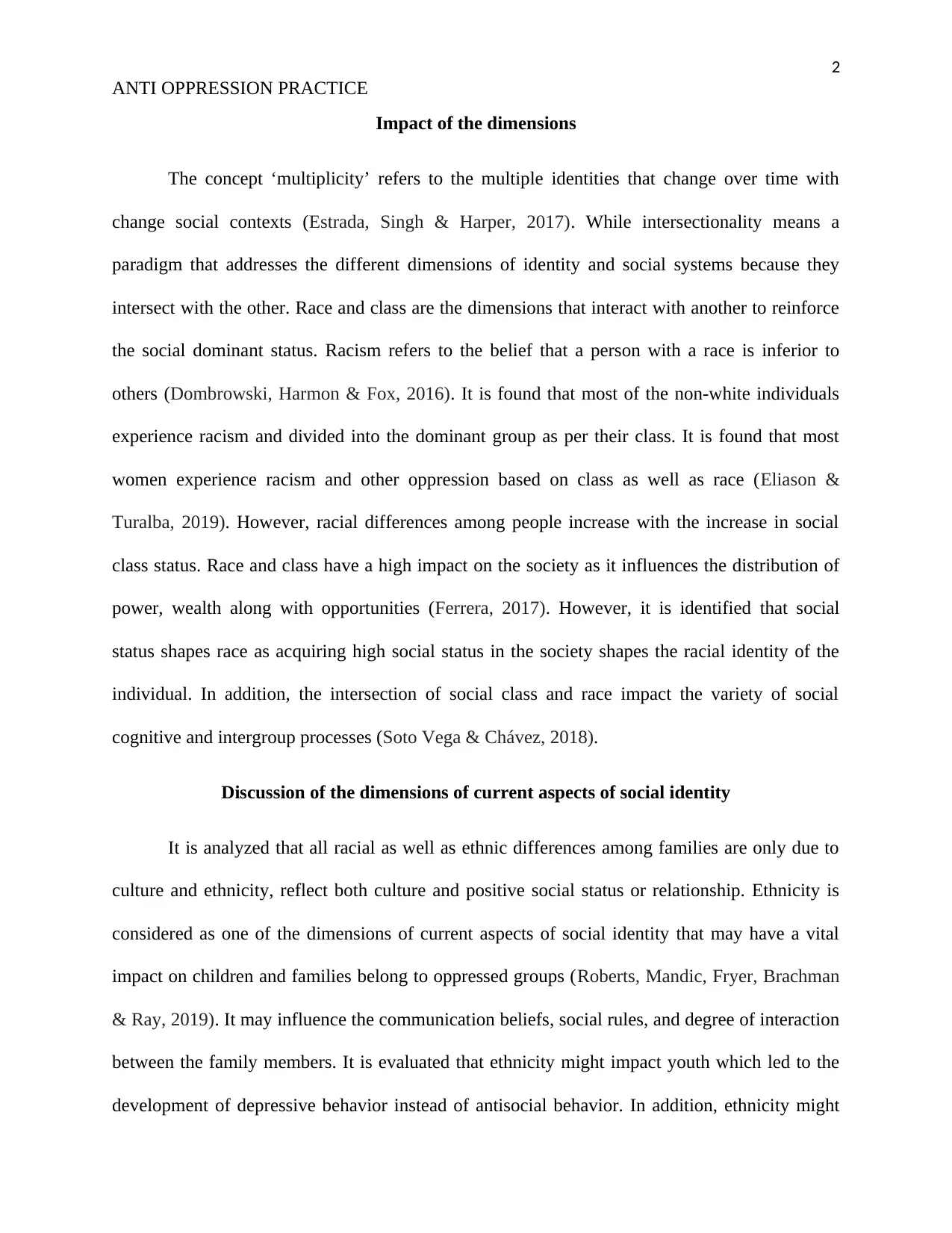
2
ANTI OPPRESSION PRACTICE
Impact of the dimensions
The concept ‘multiplicity’ refers to the multiple identities that change over time with
change social contexts (Estrada, Singh & Harper, 2017). While intersectionality means a
paradigm that addresses the different dimensions of identity and social systems because they
intersect with the other. Race and class are the dimensions that interact with another to reinforce
the social dominant status. Racism refers to the belief that a person with a race is inferior to
others (Dombrowski, Harmon & Fox, 2016). It is found that most of the non-white individuals
experience racism and divided into the dominant group as per their class. It is found that most
women experience racism and other oppression based on class as well as race (Eliason &
Turalba, 2019). However, racial differences among people increase with the increase in social
class status. Race and class have a high impact on the society as it influences the distribution of
power, wealth along with opportunities (Ferrera, 2017). However, it is identified that social
status shapes race as acquiring high social status in the society shapes the racial identity of the
individual. In addition, the intersection of social class and race impact the variety of social
cognitive and intergroup processes (Soto Vega & Chávez, 2018).
Discussion of the dimensions of current aspects of social identity
It is analyzed that all racial as well as ethnic differences among families are only due to
culture and ethnicity, reflect both culture and positive social status or relationship. Ethnicity is
considered as one of the dimensions of current aspects of social identity that may have a vital
impact on children and families belong to oppressed groups (Roberts, Mandic, Fryer, Brachman
& Ray, 2019). It may influence the communication beliefs, social rules, and degree of interaction
between the family members. It is evaluated that ethnicity might impact youth which led to the
development of depressive behavior instead of antisocial behavior. In addition, ethnicity might
ANTI OPPRESSION PRACTICE
Impact of the dimensions
The concept ‘multiplicity’ refers to the multiple identities that change over time with
change social contexts (Estrada, Singh & Harper, 2017). While intersectionality means a
paradigm that addresses the different dimensions of identity and social systems because they
intersect with the other. Race and class are the dimensions that interact with another to reinforce
the social dominant status. Racism refers to the belief that a person with a race is inferior to
others (Dombrowski, Harmon & Fox, 2016). It is found that most of the non-white individuals
experience racism and divided into the dominant group as per their class. It is found that most
women experience racism and other oppression based on class as well as race (Eliason &
Turalba, 2019). However, racial differences among people increase with the increase in social
class status. Race and class have a high impact on the society as it influences the distribution of
power, wealth along with opportunities (Ferrera, 2017). However, it is identified that social
status shapes race as acquiring high social status in the society shapes the racial identity of the
individual. In addition, the intersection of social class and race impact the variety of social
cognitive and intergroup processes (Soto Vega & Chávez, 2018).
Discussion of the dimensions of current aspects of social identity
It is analyzed that all racial as well as ethnic differences among families are only due to
culture and ethnicity, reflect both culture and positive social status or relationship. Ethnicity is
considered as one of the dimensions of current aspects of social identity that may have a vital
impact on children and families belong to oppressed groups (Roberts, Mandic, Fryer, Brachman
& Ray, 2019). It may influence the communication beliefs, social rules, and degree of interaction
between the family members. It is evaluated that ethnicity might impact youth which led to the
development of depressive behavior instead of antisocial behavior. In addition, ethnicity might
⊘ This is a preview!⊘
Do you want full access?
Subscribe today to unlock all pages.

Trusted by 1+ million students worldwide
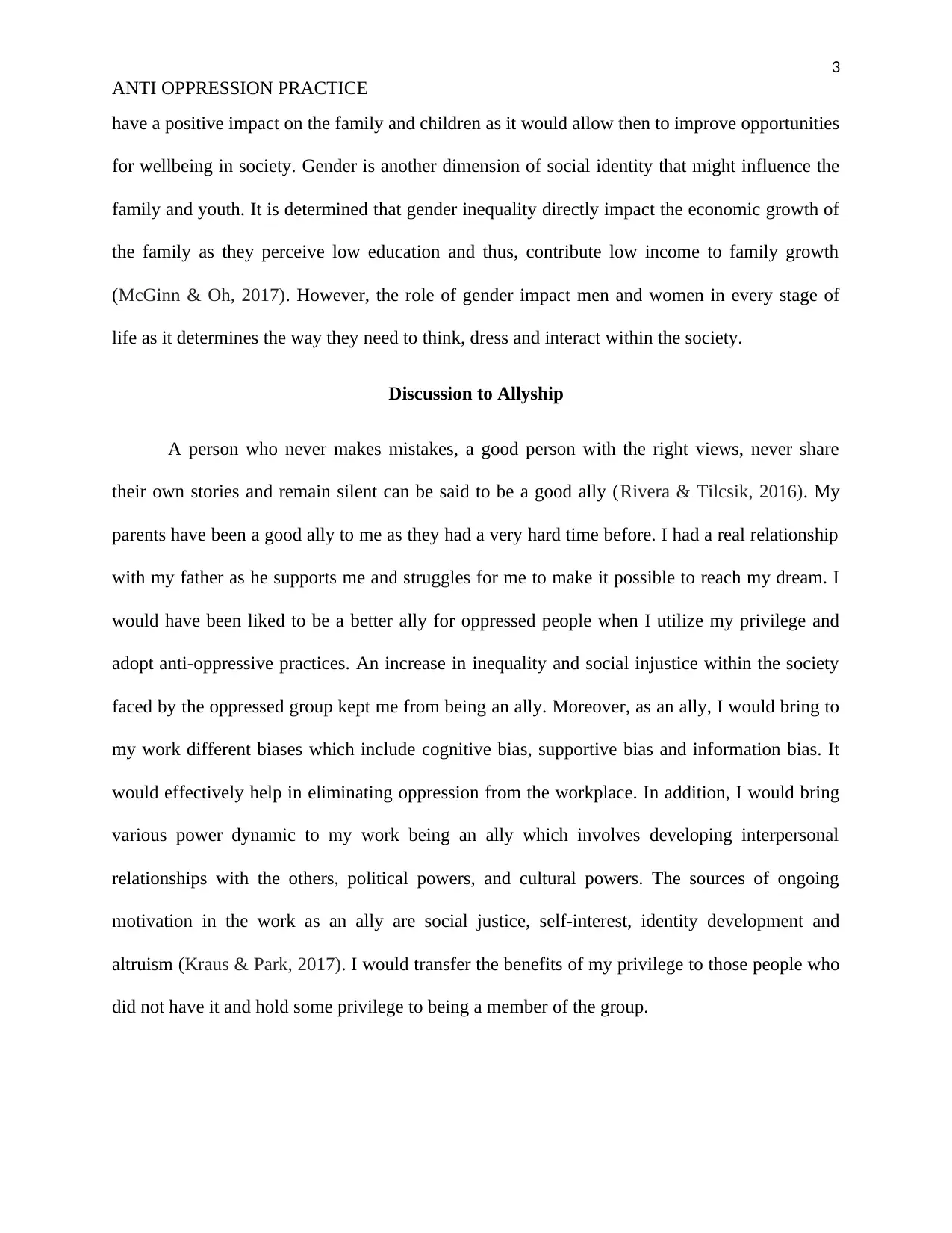
3
ANTI OPPRESSION PRACTICE
have a positive impact on the family and children as it would allow then to improve opportunities
for wellbeing in society. Gender is another dimension of social identity that might influence the
family and youth. It is determined that gender inequality directly impact the economic growth of
the family as they perceive low education and thus, contribute low income to family growth
(McGinn & Oh, 2017). However, the role of gender impact men and women in every stage of
life as it determines the way they need to think, dress and interact within the society.
Discussion to Allyship
A person who never makes mistakes, a good person with the right views, never share
their own stories and remain silent can be said to be a good ally (Rivera & Tilcsik, 2016). My
parents have been a good ally to me as they had a very hard time before. I had a real relationship
with my father as he supports me and struggles for me to make it possible to reach my dream. I
would have been liked to be a better ally for oppressed people when I utilize my privilege and
adopt anti-oppressive practices. An increase in inequality and social injustice within the society
faced by the oppressed group kept me from being an ally. Moreover, as an ally, I would bring to
my work different biases which include cognitive bias, supportive bias and information bias. It
would effectively help in eliminating oppression from the workplace. In addition, I would bring
various power dynamic to my work being an ally which involves developing interpersonal
relationships with the others, political powers, and cultural powers. The sources of ongoing
motivation in the work as an ally are social justice, self-interest, identity development and
altruism (Kraus & Park, 2017). I would transfer the benefits of my privilege to those people who
did not have it and hold some privilege to being a member of the group.
ANTI OPPRESSION PRACTICE
have a positive impact on the family and children as it would allow then to improve opportunities
for wellbeing in society. Gender is another dimension of social identity that might influence the
family and youth. It is determined that gender inequality directly impact the economic growth of
the family as they perceive low education and thus, contribute low income to family growth
(McGinn & Oh, 2017). However, the role of gender impact men and women in every stage of
life as it determines the way they need to think, dress and interact within the society.
Discussion to Allyship
A person who never makes mistakes, a good person with the right views, never share
their own stories and remain silent can be said to be a good ally (Rivera & Tilcsik, 2016). My
parents have been a good ally to me as they had a very hard time before. I had a real relationship
with my father as he supports me and struggles for me to make it possible to reach my dream. I
would have been liked to be a better ally for oppressed people when I utilize my privilege and
adopt anti-oppressive practices. An increase in inequality and social injustice within the society
faced by the oppressed group kept me from being an ally. Moreover, as an ally, I would bring to
my work different biases which include cognitive bias, supportive bias and information bias. It
would effectively help in eliminating oppression from the workplace. In addition, I would bring
various power dynamic to my work being an ally which involves developing interpersonal
relationships with the others, political powers, and cultural powers. The sources of ongoing
motivation in the work as an ally are social justice, self-interest, identity development and
altruism (Kraus & Park, 2017). I would transfer the benefits of my privilege to those people who
did not have it and hold some privilege to being a member of the group.
Paraphrase This Document
Need a fresh take? Get an instant paraphrase of this document with our AI Paraphraser
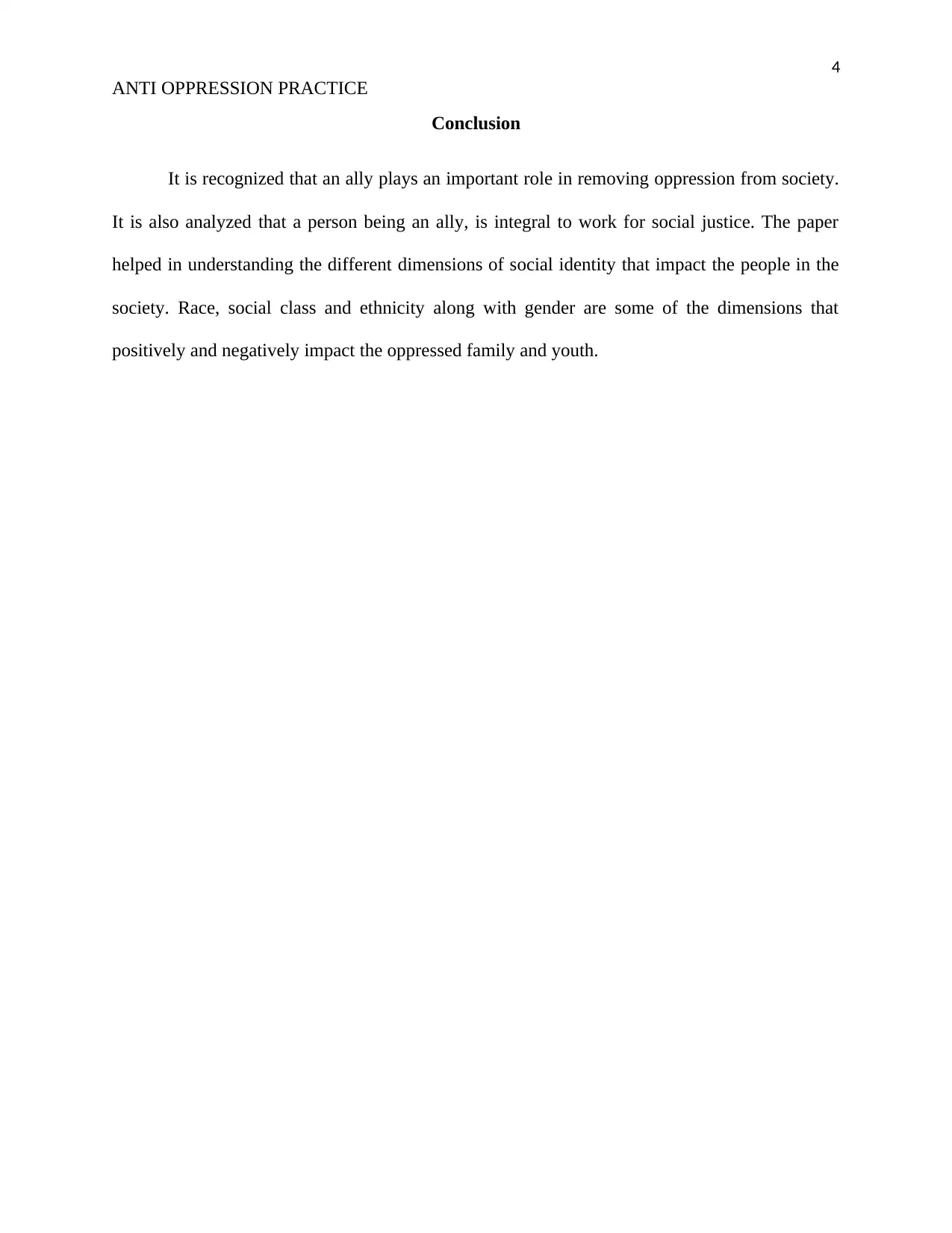
4
ANTI OPPRESSION PRACTICE
Conclusion
It is recognized that an ally plays an important role in removing oppression from society.
It is also analyzed that a person being an ally, is integral to work for social justice. The paper
helped in understanding the different dimensions of social identity that impact the people in the
society. Race, social class and ethnicity along with gender are some of the dimensions that
positively and negatively impact the oppressed family and youth.
ANTI OPPRESSION PRACTICE
Conclusion
It is recognized that an ally plays an important role in removing oppression from society.
It is also analyzed that a person being an ally, is integral to work for social justice. The paper
helped in understanding the different dimensions of social identity that impact the people in the
society. Race, social class and ethnicity along with gender are some of the dimensions that
positively and negatively impact the oppressed family and youth.
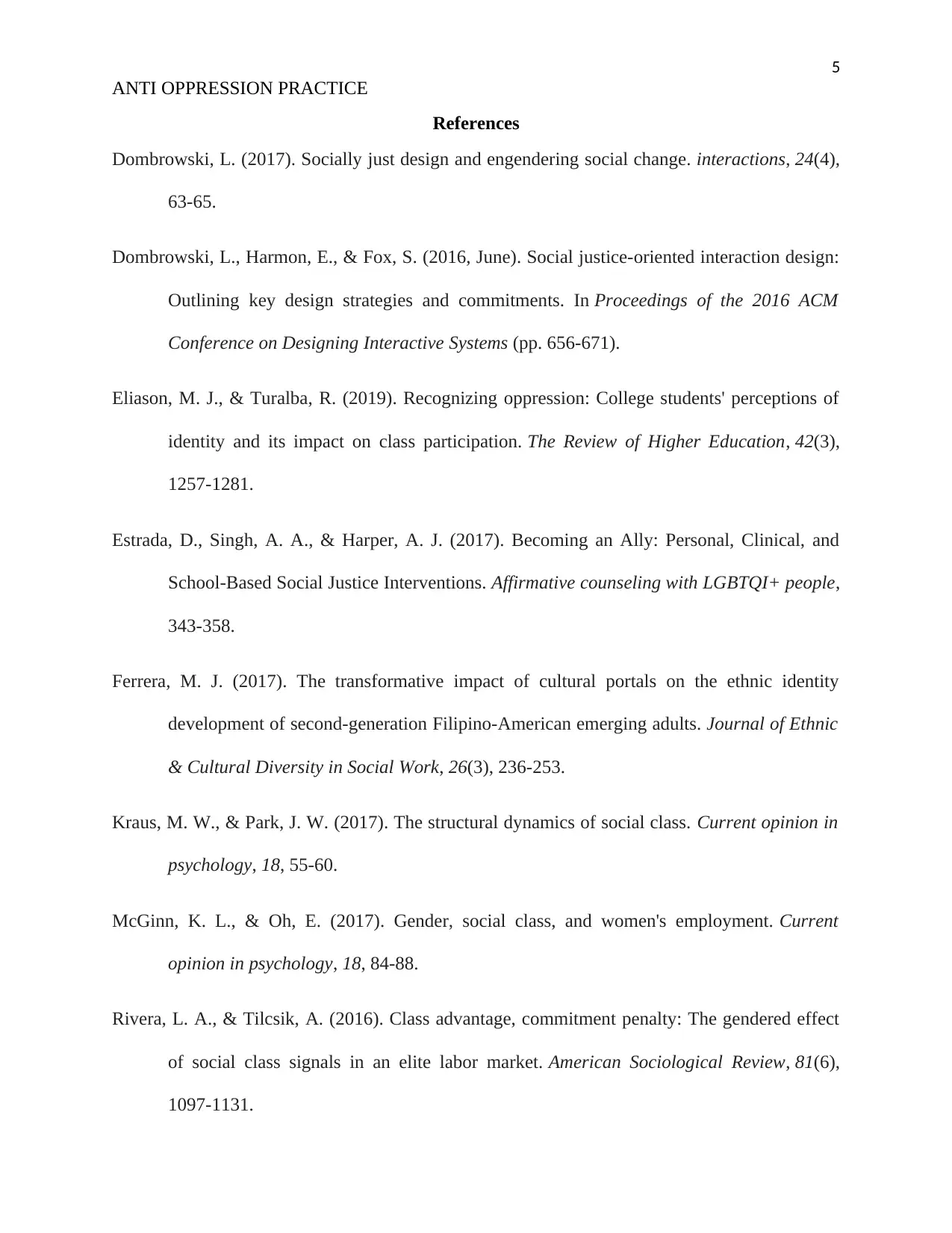
5
ANTI OPPRESSION PRACTICE
References
Dombrowski, L. (2017). Socially just design and engendering social change. interactions, 24(4),
63-65.
Dombrowski, L., Harmon, E., & Fox, S. (2016, June). Social justice-oriented interaction design:
Outlining key design strategies and commitments. In Proceedings of the 2016 ACM
Conference on Designing Interactive Systems (pp. 656-671).
Eliason, M. J., & Turalba, R. (2019). Recognizing oppression: College students' perceptions of
identity and its impact on class participation. The Review of Higher Education, 42(3),
1257-1281.
Estrada, D., Singh, A. A., & Harper, A. J. (2017). Becoming an Ally: Personal, Clinical, and
School‐Based Social Justice Interventions. Affirmative counseling with LGBTQI+ people,
343-358.
Ferrera, M. J. (2017). The transformative impact of cultural portals on the ethnic identity
development of second-generation Filipino-American emerging adults. Journal of Ethnic
& Cultural Diversity in Social Work, 26(3), 236-253.
Kraus, M. W., & Park, J. W. (2017). The structural dynamics of social class. Current opinion in
psychology, 18, 55-60.
McGinn, K. L., & Oh, E. (2017). Gender, social class, and women's employment. Current
opinion in psychology, 18, 84-88.
Rivera, L. A., & Tilcsik, A. (2016). Class advantage, commitment penalty: The gendered effect
of social class signals in an elite labor market. American Sociological Review, 81(6),
1097-1131.
ANTI OPPRESSION PRACTICE
References
Dombrowski, L. (2017). Socially just design and engendering social change. interactions, 24(4),
63-65.
Dombrowski, L., Harmon, E., & Fox, S. (2016, June). Social justice-oriented interaction design:
Outlining key design strategies and commitments. In Proceedings of the 2016 ACM
Conference on Designing Interactive Systems (pp. 656-671).
Eliason, M. J., & Turalba, R. (2019). Recognizing oppression: College students' perceptions of
identity and its impact on class participation. The Review of Higher Education, 42(3),
1257-1281.
Estrada, D., Singh, A. A., & Harper, A. J. (2017). Becoming an Ally: Personal, Clinical, and
School‐Based Social Justice Interventions. Affirmative counseling with LGBTQI+ people,
343-358.
Ferrera, M. J. (2017). The transformative impact of cultural portals on the ethnic identity
development of second-generation Filipino-American emerging adults. Journal of Ethnic
& Cultural Diversity in Social Work, 26(3), 236-253.
Kraus, M. W., & Park, J. W. (2017). The structural dynamics of social class. Current opinion in
psychology, 18, 55-60.
McGinn, K. L., & Oh, E. (2017). Gender, social class, and women's employment. Current
opinion in psychology, 18, 84-88.
Rivera, L. A., & Tilcsik, A. (2016). Class advantage, commitment penalty: The gendered effect
of social class signals in an elite labor market. American Sociological Review, 81(6),
1097-1131.
⊘ This is a preview!⊘
Do you want full access?
Subscribe today to unlock all pages.

Trusted by 1+ million students worldwide
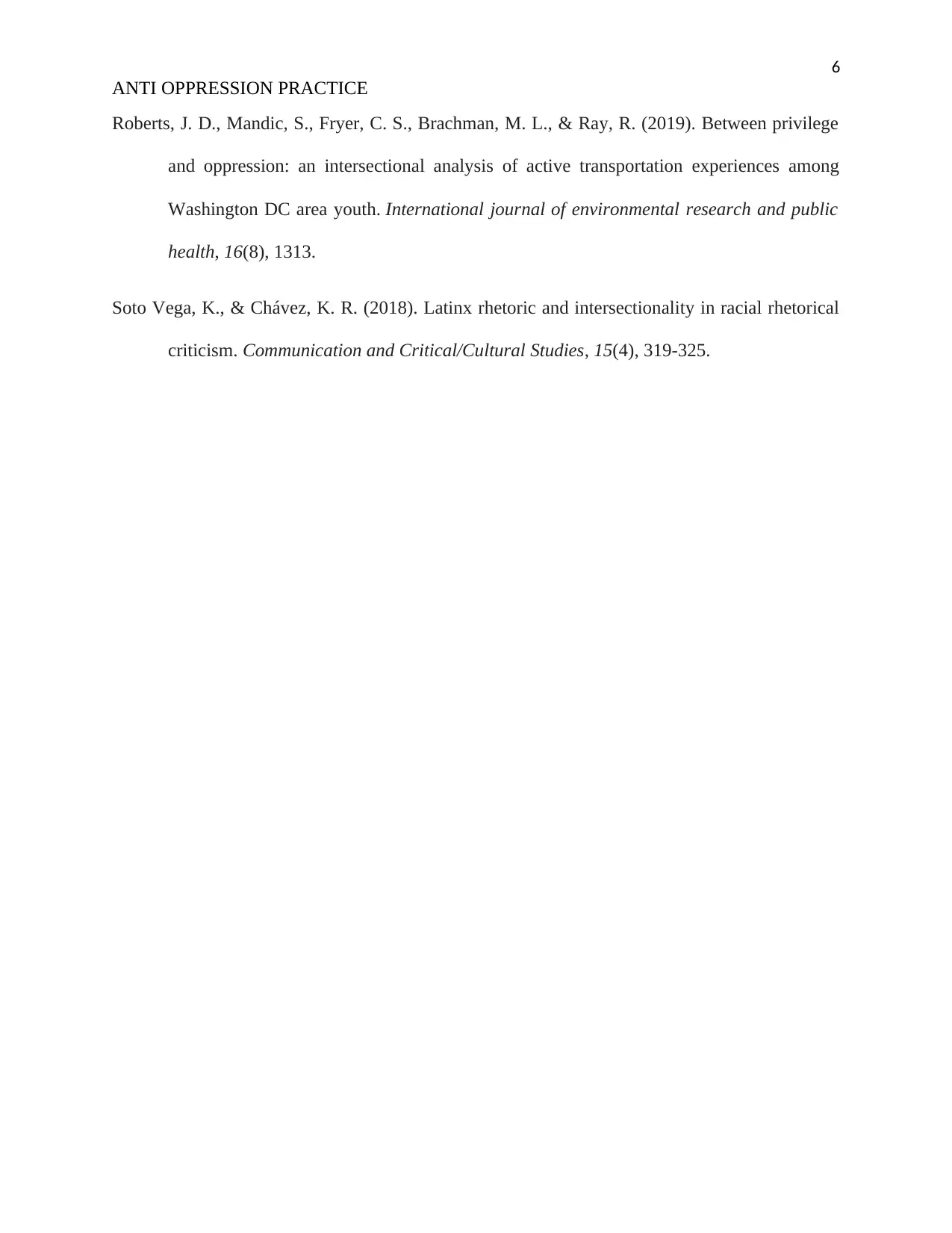
6
ANTI OPPRESSION PRACTICE
Roberts, J. D., Mandic, S., Fryer, C. S., Brachman, M. L., & Ray, R. (2019). Between privilege
and oppression: an intersectional analysis of active transportation experiences among
Washington DC area youth. International journal of environmental research and public
health, 16(8), 1313.
Soto Vega, K., & Chávez, K. R. (2018). Latinx rhetoric and intersectionality in racial rhetorical
criticism. Communication and Critical/Cultural Studies, 15(4), 319-325.
ANTI OPPRESSION PRACTICE
Roberts, J. D., Mandic, S., Fryer, C. S., Brachman, M. L., & Ray, R. (2019). Between privilege
and oppression: an intersectional analysis of active transportation experiences among
Washington DC area youth. International journal of environmental research and public
health, 16(8), 1313.
Soto Vega, K., & Chávez, K. R. (2018). Latinx rhetoric and intersectionality in racial rhetorical
criticism. Communication and Critical/Cultural Studies, 15(4), 319-325.
1 out of 7
Related Documents
Your All-in-One AI-Powered Toolkit for Academic Success.
+13062052269
info@desklib.com
Available 24*7 on WhatsApp / Email
![[object Object]](/_next/static/media/star-bottom.7253800d.svg)
Unlock your academic potential
Copyright © 2020–2025 A2Z Services. All Rights Reserved. Developed and managed by ZUCOL.





